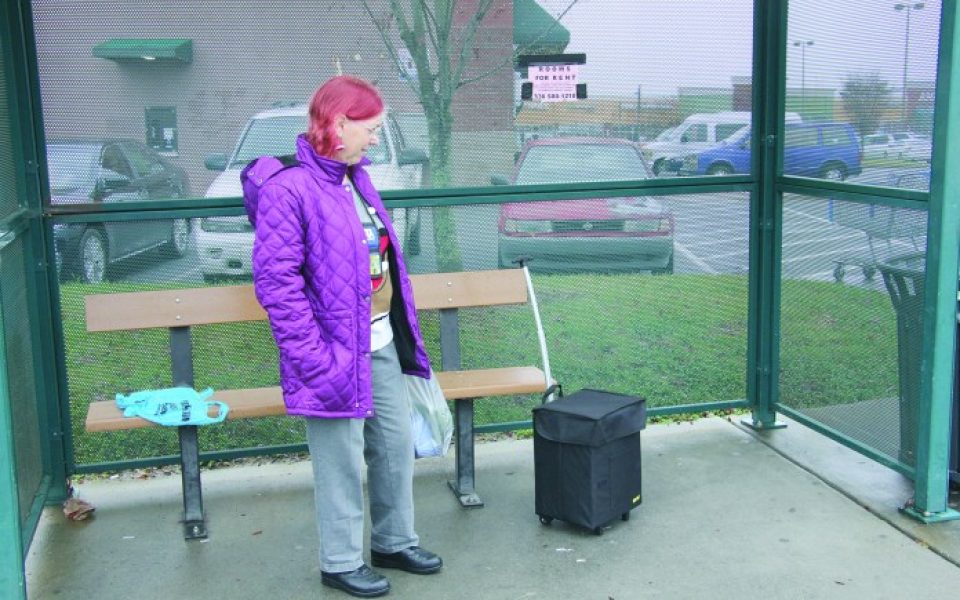by Daniel Wirtheim
The first 10 kids loosely organized a line and one by one pulled off strips. Then a few started screaming, there was a shuffling of feet and the kids started grabbing what they could and tearing away. The project didn’t all fall apart at once, but rather came apart in shapeless chunks. One kid jumped and sailed into an arm of the project, pulling it down so that even smaller kids could get at it. It was beginning to resemble more of a heap of trash than anything artistic when the adults started to get in on the action.
The installation housed in the Greenhill gallery until last week took about 70,000 coffee stirrers and 12 days to finish, but just 10 minutes to destroy.
The Raleigh-based artist Jonathan Brilliant wanted the piece dismantled when the exhibition was over. So on Aug. 26 at least 200 adults and children showed up at the Greenhill Center to party and tear down the installation called “The Greensboro Piece,” which was on display at the Greenhill gallery since mid-July.
Children took turns ripping apart the coffee stirrers that were held together by tension until the entire installation was diminished to a pile of sticks. Everyone was encouraged to rip a piece of the project off and take it home.
Brilliant’s artist statement explains that he wanted to explore his sense that “the coffee shop and related consumer environs are more organic and nurturing than the real natural environment.”
There was a feeling of coffeehouse coziness in the installation’s many nooks and coves large enough to fit a seated person. If it were not for the sheer magnitude of “The Greensboro Piece,” it might have come off as a middle school art project. But the installation did deliver some of the organic sensibilities that Brilliant was going for in its movement, the way it snaked around the room and over itself.
For an entire summer, Brilliant was an artist-in-residence at Greenhill. “The Greensboro Piece” was part of a larger series the artist is doing called Have Sticks Will Travel. In it, Brilliant makes prints, embosses and erects cavernous structures with coffee stirrers.
Ink prints made by rolling Starbucks coffee sleeves and other abstract objects crafted from coffee stirrers line the gallery walls. There’s nothing within the art itself to suggest any higher understanding of coffee culture and it doesn’t help that Brilliant wasn’t there to explain.
“Usually a curator is here to protect and serve,” Curator Edie Carpenter said. “This is the first time I’ve seen anything be destroyed here.”

©
For Carpenter, destroying the installation not only makes her job easier as the one in charge of dismantling the projects but also reinforces the idea that materials should “go on,” or be recycled by other artists. Tearing off a part of “The Greensboro Piece” meant keeping it as a souvenir.
“I think it’s a handsome piece,” attendee Jack Stratton said. “My question is where is he going to go with this? I mean he gets grants. He’s good at getting people to do that. And there’s an art to that, I guess.”
If the warmth of a shared community space was what Brilliant was going for during his residency program, he might have achieved that.
A mostly crowd in semi-formal attire sipped coffee and wine while kids played within the installation space. Thirty minutes before demolition time, children were running about with fistfuls of coffee stirrers, while swathes of the installation were left bald. When destruction time came chaos ensued.
By the end of the night, most everyone left with a piece of the project. The remaining pieces of “The Greensboro Piece” laid amidst the sweepers and children, who clutched their coffee stirrers like the trophies of a prized kill.
Join the First Amendment Society, a membership that goes directly to funding TCB‘s newsroom.
We believe that reporting can save the world.
The TCB First Amendment Society recognizes the vital role of a free, unfettered press with a bundling of local experiences designed to build community, and unique engagements with our newsroom that will help you understand, and shape, local journalism’s critical role in uplifting the people in our cities.
All revenue goes directly into the newsroom as reporters’ salaries and freelance commissions.


Leave a Reply